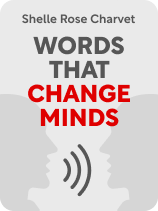

This article is an excerpt from the Shortform book guide to "Words That Change Minds" by Shelle Rose Charvet. Shortform has the world's best summaries and analyses of books you should be reading.
Like this article? Sign up for a free trial here.
Are there people in your life you just can’t understand? Does it sometimes sound like they’re speaking a different language?
In many ways, they are. Words That Change Minds, a book by Shelle Rose Charvet, contends that each individual makes sense of the world in a unique way. When two people approach the same situation with completely different frames of mind, it can cause miscommunications, conflict, and animosity.
Continue reading for an overview of this book that can help you understand others as well as speak their language.
Overview of Words That Change Minds
Words That Change Minds, a book by Shelle Rose Charvet, argues that, if you learn how another person thinks, you can consciously match their frame of reference and speak in a language they understand. This is a powerful professional skill—with it, you can build cooperative relationships with coworkers, clients, and management, as well as influence them to help you achieve your goals.
Charvet is a professional speaker and founder of the Institute for Influence, an educational organization offering online training programs in communication and persuasion. Through this organization, she has trained hundreds of professionals in 30 different countries around the world to become more effective leaders and communicators.
We’ll begin by describing the framework of mental habits people use to make sense of the world. Then we’ll outline each of the 14 mental habits that help you understand how to communicate with and influence others: the six mental habits that explain why people act the way they do and the eight that explain how they go about solving problems. We’ve rearranged the order of some of these mental habits, placing similar habits near one another to enhance flow.
(Shortform note: As Charvet acknowledges in the book, social scientist Rodger Bailey was the first to delineate this set of 14 mental habits—six explaining the “why” behind a person’s actions and eight explaining the “how.” He drew these habits from a broader list by social scientist Leslie Cameron-Bandler of 60 mental habits she calls “metaprograms.” Presumably, Bailey chose these habits from the greater list because they’re the most relevant and practical in a workplace setting. If you can motivate someone to work and let them work in the ways that suit them best, you don’t need to know any more about them to produce value.)
The Mental Habits That Shape Communication
Charvet explains that her system of analyzing the way different people think and communicate is based on a field of psychological study called neuro-linguistic programming, or NLP. According to NLP, as people learn and grow, they “program” themselves with specific mental habits that determine how they judge situations and make decisions.
These relatively fixed mental habits cause people to consistently repeat the same behavioral patterns, so if you understand someone’s mental habits, you can predict how they’ll act. For example, if someone habitually focuses on the details of a task rather than the big picture of what they’re trying to accomplish, they may fixate on a to-do list item at work that doesn’t really matter.
How to Identify Mental Habits
How do you figure out what someone’s mental habits are? According to NLP, after someone develops certain mental habits, they reveal these habits in the language they use to describe their thought processes and the world around them. For example, someone who habitually focuses on details will give an abundance of concrete information when describing a situation.
Charvet contends that, by listening closely to the language someone uses when speaking, you can identify 14 mental habits that tell you everything you need to know to communicate effectively with that person.
Charvet notes a key difference between this theory and other personality profiles (like the Myers-Briggs Type Indicator or the Big Five personality traits): This framework acknowledges that the same person utilizes different mental habits in different situations. Identifying a mental habit someone uses doesn’t mean you’ve uncovered a core, unchanging part of their personality—you’ve just identified a situational behavior pattern that they’ll likely repeat in a similar situation.
Mirror Mental Habits to Communicate Well
Once you’ve identified someone’s mental habits, you need to mirror their linguistic style to effectively communicate with and influence them, according to Charvet. Speaking in the terms people naturally use to think and communicate will make you seem more rational and convincing.
In the workplace, mirroring other people’s language will help you convince them that your ideas are valuable, avoid conflicts rooted in misunderstanding or perceived disrespect, and encourage the people you’re managing or coaching to be more receptive to your advice. For example, if you notice that someone you’re mentoring talks a lot about how their work makes others feel, you could influence them to stop being late for meetings by mirroring that kind of language: “The team and I get a bit irritated whenever we have to wait for you to get here.”
The Six “Why” Mental Habits
The first six of the 14 mental habits reveal the reasons why an individual chooses to solve a problem (or not). For this reason, we’ll call these six the “Why” mental habits (Charvet refers to them as the six “Motivation Patterns.”)
The majority of these mental habits are based on a dichotomy between two opposites. According to Charvet, this doesn’t mean that people are either one or the other—rather, the habits form a spectrum, and individuals often fall somewhere in between. For example, while some people prefer to work with a team and others prefer to work alone, there are also those who equally enjoy working with others and by themselves.
Why Habit #1: Active or Passive
The first Why habit we’ll discuss refers to someone’s readiness to spur themselves into action: Are they active or passive? (Charvet calls this the “Level” category.) Active people progress toward their goals as quickly as possible, while passive people tend to wait and analyze the situation until the perfect opportunity arises or someone else pushes them into action.
You can tell someone is active if they speak in short, direct sentences that emphasize simple cause-and-effect sequences, asserts Charvet. To communicate effectively with an active person, mirror this effect. For example, you could say, “We’re downsizing to keep this branch profitable.”
In contrast, passive people speak in long, often meandering sentences that highlight the subtle complexities of a situation. To break downsizing news to a passive person, you might say, “Although there’s great work being done in every department, it’s likely that we’ll start running a deficit unless we downsize to reduce our current expenses.”
Why Habit #2: Positively or Negatively Incentivized
The second Why habit describes whether someone feels more motivated by the promise of a reward or by the threat of negative consequences: Are they positively or negatively incentivized? (Charvet calls this the “Direction” category.)
According to Charvet, someone who’s positively incentivized will frequently talk about their goals—what they want to achieve and add to their life. For example, they might excitedly tell you, “If this project succeeds, we’ll have the only product of its kind on the market.” On the other hand, someone who’s negatively incentivized will tend to talk about their fears and problems—what they want to keep out of their life. They would emphasize that “Unless we get this product to market quickly, we’ll fall behind our competitors.”
To influence someone to take action, talk to positively incentivized people about opportunities they can gain and negatively incentivized people about threats they should avoid.
Why Habit #3: Self-Validated or Validated by Others
The third Why habit refers to how people decide what to do and how they assess if they’re doing it well: They’re either self-validated or validated by others. (Charvet calls this the “Source” category.) Self-validated people only want to work if they believe they’re successfully doing something important. People validated by others only like working if someone like a boss or coworker tells them they’re doing a good job at something important.
Self-validated people make frequent judgments about their work and the work of others: For example, they might say, “My presentation at today’s meeting went well. Although I was a little less organized than Justin, my visual aids got my point across well.” In contrast, people validated by others defer to other people’s opinions when judging someone’s work: “I think I had a good presentation today. Justin told me he was impressed, and I saw Michelle nodding a lot.”
Charvet notes that because they’re so self-assured, persuading someone self-validated to change their mind can be a challenge. If you’re trying to influence them, make sure to use suggestions rather than instructions. For instance, you could say, “If you want your message to be as clear as possible, you may want to cut each of your presentation slides down to a couple of bullet points.”
People validated by others are much easier to influence—just strongly assert what you believe to be true or cite the standards of others: “You should keep your slides more concise. Michelle always responds well to a focused presentation.”
Why Habit #4: Reliable or Innovative
The fourth Why habit describes how attached someone is to one specific way of solving a problem: They’re either reliable or innovative. (Charvet calls this the “Reason” category.) Reliable people identify one way to solve a problem and strive to consistently repeat their successes in the same way, while innovative people are always on the lookout for new and better ways to solve the same problems.
You can tell someone is reliable if they describe their actions as if they were out of their control, writes Charvet. For example, a reliable person would tell you “I had to stay six hours overtime last week to finish up that urgent project.” Innovative people, on the other hand, will dissect the factors influencing every decision they make and highlight the other choices they could have made: “I could have left that project for Monday rather than putting in extra hours, but I wanted my boss to see how dedicated I am. Plus, I thought it’d be nice to grab an overtime bonus before the holidays.”
To communicate effectively, mirror the other person’s view of problem-solving: Emphasize either the one right way to do something or the variety of options they have when approaching it.
Why Habit #5: Eager for Change or Content With Stability
The fifth Why habit we’ll discuss refers to how often someone wants to upend the status quo: Are they eager for change or content with stability? (Charvet calls this the “Decision Factors” category.) That is, do they want to constantly shake things up in their life or keep things the same for as long as possible?
When thinking about the past, people who are more eager for change will highlight how much things have changed—they might say, “Running a nonprofit is much more fulfilling than my career managing restaurants.” Someone content with stability with the same résumé would focus on the things that stayed the same: “I’ve been a manager for the last 20 years.”
If you want to influence someone eager for change to do something, emphasize how exciting and new it is (“Going to college would be a whole new adventure for you!”). If they’re content with stability, emphasize how it’s similar to things they’ve done in the past (“I think continuing your education would really help you maintain your personal growth”).
Why Habit #6: Ideals
The sixth Why habit is a bit different than the other five—instead of existing on a spectrum between two types, people can express this habit in infinite ways. Charvet argues that everyone has a unique set of ideals, specific words that represent the things or attributes that are most important to them. (Charvet calls these ideals “Criteria.”) For instance, if someone says they love their job because they’re working toward a noble mission and get to spend time with a supportive team, “noble mission” and “supportive team” might be two of their ideals.
If you refer to one of someone’s ideals using different words, it won’t mean the same thing to them. Charvet contends that a person’s ideals—the words themselves—are tied to myriad emotional memories that give the words their motivating power. Thus, when trying to communicate with or influence someone, only refer to their ideals using their exact words. To return to our example above, you could convince that person to volunteer at your organization by emphasizing the noble mission you and your supportive team are looking to achieve.
The Eight “How” Mental Habits
The final eight mental habits explain how an individual does their best work after they’ve decided to solve a problem. We’ll call these the eight “How” mental habits (“Productivity Patterns,” in Charvet’s words).
According to Charvet, understanding How habits is particularly important for managers who need to assign tasks to team members, as these mental habits reveal individuals’ strengths and weaknesses in the workplace. To maximize productivity, assign team members tasks that require them to think as they’re naturally inclined to think.
As with Why habits, most How habits lie on a spectrum between two opposites, and verbally mirroring someone’s habit-driven language is one of the best ways to communicate with and influence them.
How Habit #1: Whole-Oriented or Detail-Oriented
The first How habit we’ll discuss describes whether someone is more insightful when looking at the big picture or individual situations: Are they whole-oriented or detail-oriented? (Charvet calls this the “Scope” category.)
Whole-oriented people tend to speak in abstract, sometimes vague terms, writes Charvet. They might say, “We decided to move Brian to the sales team.” In contrast, detail-oriented people tend to describe concrete situations, sometimes in painstaking detail: “Last Friday, Trudy, Mark, and I met in Conference Room B and decided that Brian would be a better fit on the sales team because of how much he’s improved his people skills.”
Make sure to talk in terms of the big picture with whole-oriented people; otherwise, they’ll either get bored or feel overwhelmed. Likewise, speak in comprehensive, concrete terms with detail-oriented people, or they’ll become frustrated with your vague language.
How Habit #2: Level-Headed or Neurotic
The second How habit is a description of how someone reacts to high-pressure situations: Are they level-headed or neurotic? Do they address intense events with cool, dispassionate logic, or do they frequently become emotionally overwhelmed? (Charvet calls this the “Stress Response” category.)
Charvet clarifies that unlike most of the other mental habits, this one isn’t revealed through the words someone says. You can gauge whether someone is level-headed or neurotic by paying attention to how outwardly emotional they are while speaking, especially when discussing a challenging situation. Level-headed people typically stay low-key and detached in conversation, while neurotic people visibly display emotions with their whole bodies—for instance, slumping their shoulders and collapsing into a chair when describing an exhausting day at work.
To influence level-headed people, take care to explain your point of view with airtight logic. To influence neurotic people, speak in emotional language that gets them excited to act.
How Habit #3: Team Player or Lone Wolf
The third How habit refers to someone’s preferred level of interaction with other people: Are they a team player or a lone wolf? (Charvet calls this the “Style” category.) Team players do their best work in close collaboration with others—when they’re alone, they may struggle to focus and get things done. In contrast, lone wolves need their own space to do their best work and get distracted if other people are nearby.
To identify whether someone is a team player or a lone wolf, pay attention to how much they mention others when describing their tasks. Team players emphasize the actions of those around them: They might say “We launched our new ad campaign before the deadline we set for ourselves.” Lone wolves emphasize the actions and decisions they make as individuals: “I finished designing the full set of banner ads two months before launch day.”
If you’re managing a team, Charvet recommends that you make sure that team players have opportunities to collaborate with their coworkers while also making sure lone wolves have the personal time and space they need to do their work alone.
How Habit #4: Interpersonally Aware or Self-Preoccupied
The fourth How habit describes someone’s sensitivity to nonverbal signals when interacting with others: They’re either interpersonally aware or self-preoccupied. (Charvet calls this the “Attention Direction” category.) People who are interpersonally aware are constantly monitoring the emotions and thoughts of those around them, while self-preoccupied people are only aware of their own emotions and thoughts.
Charvet contends that you can differentiate interpersonally aware and self-preoccupied people through their body language: Interpersonally aware people will display animated movements and facial expressions, whereas self-preoccupied people will generally display a flat affect.
Because your thoughts and emotions have such an impact on interpersonally aware people, send friendly nonverbal signals to make them more receptive to what you’re trying to say. On the other hand, self-preoccupied people typically won’t pick up on these signals.
How Habit #5: Empathetic or Analytic
The fifth How habit we’ll discuss refers to how much someone believes emotions are a part of their work: Are they empathetic or analytic? (Charvet calls this the “Organization” category.) Empathetic people see all their tasks as primarily emotional endeavors—the whole point of the work they do is to positively impact someone emotionally (clients, co-workers, or anyone else they interact with). Analytic people, on the other hand, choose to focus on completing meaningful tasks without regard for how those around them feel.
Charvet explains that when discussing their work, empathetic people will describe how it made them and those around them feel. Mirror this when communicating with them—you might praise an empathetic person by saying, “I loved your proposal to construct a new branch downtown, and the shareholders are going to love it, too.” On the other hand, when discussing their work, analytic people will simply describe the tasks they completed. You can appeal to them by similarly focusing on the work: “Your proposal is great. It’s very well-researched.”
How Habit #6: Personal Standards
The sixth How habit describes the behavioral standards someone expects themselves and others to meet. (Charvet calls this the “Rule Structure” category.)
According to Charvet, people can have one of four possible types of personal standards: objective, subjective, external, and egocentric. People with objective standards believe that certain behavior is objectively virtuous and desirable, judging everyone’s work (including their own) by the same criteria. In contrast, people with subjective standards believe that what’s good for one individual might not be good for another, and they tend to avoid judging or intervening in the behavior of others.
People with external standards need someone or something to tell them what behavior is appropriate or objectively good. They then apply these rules as objective standards for themselves and others. Finally, people with egocentric standards do whatever they believe is best and completely disregard the behavior of others. They also disregard whatever standards others have for them.
Charvet recommends discerning someone’s personal standards by directly asking them how they would ideally behave at work, then asking how someone else should ideally behave at work. To influence someone, appeal to their personal standards. For example, if someone has subjective standards, you might say, “Attending this leadership conference might not benefit everyone, but I think it would serve you well.”
How Habit #7: Persuasion Style
The seventh How habit refers to the kind of evidence people need to encounter before changing their mind about something. We’ll call someone’s preference for one form of evidence their persuasion style. (Charvet calls this the “Convincer Channel” category.)
Charvet asserts that everybody has one of four persuasion styles: They find visual evidence, auditory evidence, written evidence, or experiential evidence the most persuasive. You can discern which persuasion style someone has by asking them how they came to a certain conclusion; for instance, you could ask how they determined that their current job was right for them. The evidence they used to reach their answer will correspond with one of the four persuasion styles.
To get someone to come to a certain conclusion after you’ve discerned their persuasion style, present them with their preferred form of evidence. For example, if you want to persuade someone that your restaurant is successful so they give you a loan for expansion, you can show them charts of your profits as visual evidence, practice a compelling business pitch as auditory evidence, show them customer reviews as written evidence, or let them taste your food as experiential evidence.
How Habit #8: Persuasion Requirements
The final How habit also has to do with persuasion, describing how much evidence someone needs before they change their mind. We’ll call this baseline of evidence their persuasion requirements. (Charvet calls this the “Convincer Mode” category.)
According to Charvet, people have one of four kinds of persuasion requirements: If someone needs to see evidence a specific number of times before believing it, they have quantity-based requirements. If someone believes evidence only after a certain amount of time has passed, they have time-based requirements.
If someone believes everything after encountering just one piece of evidence—or no evidence—they have minimal requirements. If someone never fully believes anything, no matter how much evidence they see, they have strict requirements. (You can still persuade them to act a certain way, but they’ll never fully adopt your way of thinking. You’ll need to re-argue your point every time you want them to do something.)
You can identify someone’s persuasion requirements by posing a hypothetical situation and directly asking them how many times they would need to encounter evidence before coming to a conclusion about that situation. For instance, you could say, “If you were looking to partner with a marketing agency, how many times would you have to meet with them before making a deal?” Even if they don’t give an exact number, their answer will reveal their persuasion requirements.
To influence someone, fulfill their persuasion requirements—give them the amount of evidence or time they need to change their mind. For example, if the person giving your restaurant a loan has strict persuasion requirements, you can convince them to give you a loan by repeating the main points of your business pitch every time you meet with them.

———End of Preview———
Like what you just read? Read the rest of the world's best book summary and analysis of Shelle Rose Charvet's "Words That Change Minds" at Shortform.
Here's what you'll find in our full Words That Change Minds summary:
- Why it's sometimes hard to understand what others are trying to say
- The 14 kinds of mental habits that explain how people think
- How to understand others better and build positive relationships






